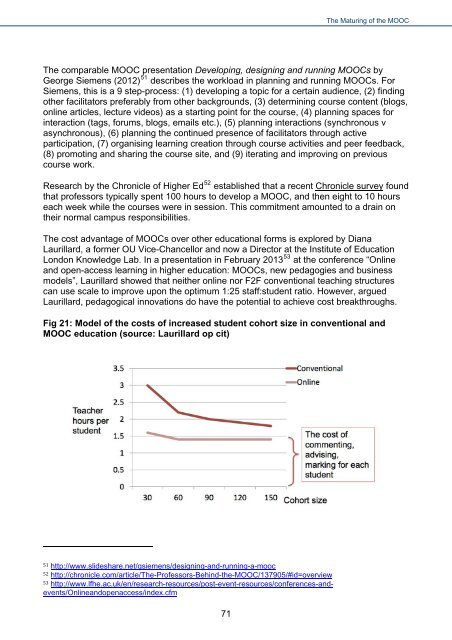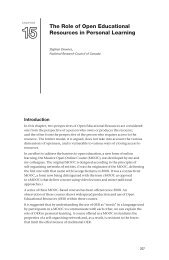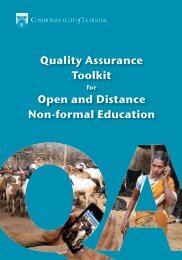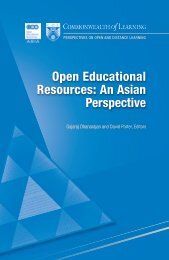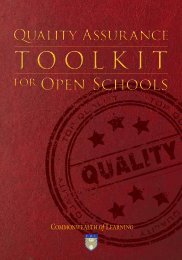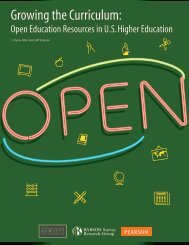The Maturing of the MOOC
The maturing of the MOOC: literature review of massive ... - Gov.uk
The maturing of the MOOC: literature review of massive ... - Gov.uk
- No tags were found...
You also want an ePaper? Increase the reach of your titles
YUMPU automatically turns print PDFs into web optimized ePapers that Google loves.
<strong>The</strong> <strong>Maturing</strong> <strong>of</strong> <strong>the</strong> <strong>MOOC</strong><br />
<strong>The</strong> comparable <strong>MOOC</strong> presentation Developing, designing and running <strong>MOOC</strong>s by<br />
George Siemens (2012) 51 describes <strong>the</strong> workload in planning and running <strong>MOOC</strong>s. For<br />
Siemens, this is a 9 step-process: (1) developing a topic for a certain audience, (2) finding<br />
o<strong>the</strong>r facilitators preferably from o<strong>the</strong>r backgrounds, (3) determining course content (blogs,<br />
online articles, lecture videos) as a starting point for <strong>the</strong> course, (4) planning spaces for<br />
interaction (tags, forums, blogs, emails etc.), (5) planning interactions (synchronous v<br />
asynchronous), (6) planning <strong>the</strong> continued presence <strong>of</strong> facilitators through active<br />
participation, (7) organising learning creation through course activities and peer feedback,<br />
(8) promoting and sharing <strong>the</strong> course site, and (9) iterating and improving on previous<br />
course work.<br />
Research by <strong>the</strong> Chronicle <strong>of</strong> Higher Ed 52 established that a recent Chronicle survey found<br />
that pr<strong>of</strong>essors typically spent 100 hours to develop a <strong>MOOC</strong>, and <strong>the</strong>n eight to 10 hours<br />
each week while <strong>the</strong> courses were in session. This commitment amounted to a drain on<br />
<strong>the</strong>ir normal campus responsibilities.<br />
<strong>The</strong> cost advantage <strong>of</strong> <strong>MOOC</strong>s over o<strong>the</strong>r educational forms is explored by Diana<br />
Laurillard, a former OU Vice-Chancellor and now a Director at <strong>the</strong> Institute <strong>of</strong> Education<br />
London Knowledge Lab. In a presentation in February 2013 53 at <strong>the</strong> conference “Online<br />
and open-access learning in higher education: <strong>MOOC</strong>s, new pedagogies and business<br />
models”, Laurillard showed that nei<strong>the</strong>r online nor F2F conventional teaching structures<br />
can use scale to improve upon <strong>the</strong> optimum 1:25 staff:student ratio. However, argued<br />
Laurillard, pedagogical innovations do have <strong>the</strong> potential to achieve cost breakthroughs.<br />
Fig 21: Model <strong>of</strong> <strong>the</strong> costs <strong>of</strong> increased student cohort size in conventional and<br />
<strong>MOOC</strong> education (source: Laurillard op cit)<br />
51 http://www.slideshare.net/gsiemens/designing-and-running-a-mooc<br />
52 http://chronicle.com/article/<strong>The</strong>-Pr<strong>of</strong>essors-Behind-<strong>the</strong>-<strong>MOOC</strong>/137905/#id=overview<br />
53 http://www.lfhe.ac.uk/en/research-resources/post-event-resources/conferences-andevents/Onlineandopenaccess/index.cfm<br />
71


